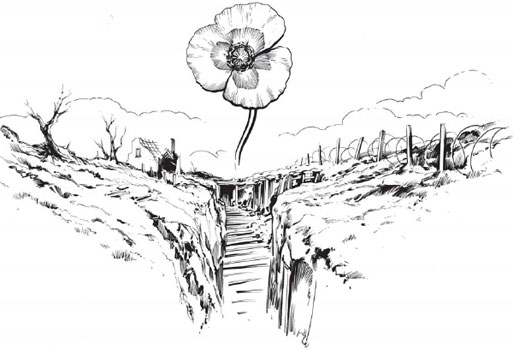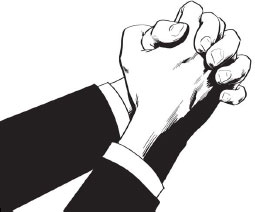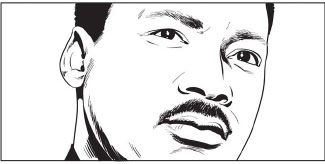The Dangerous Book of Heroes (54 page)
Read The Dangerous Book of Heroes Online
Authors: Conn Iggulden

In the first week, more than 1¼ million people passed the grave of the Unknown Warrior, mourners from the Channel Islands, England, Ireland, the Isle of Man, Scotland, Wales, and countries abroad. A policeman recorded: “One old lady came from the far north of Scotland. She carried a bunch of withered flowers, and told me with tears in her eyes that the flowers came from a little garden which her boy had planted when he was only six.”
On November 18 the grave was finally closed and filled with the earth from the battlefields of the western front. A temporary marble slab covered the opening, on which was inscribed
A BRITISH WARRIOR WHO FELL IN THE GREAT WAR
1914â18.
FOR KING AND COUNTRY. GREATER LOVE HATH NO MAN THAN THIS
. Again, the Union Jack covered the tomb. The mourners continued their pilgrimage for almost a year, leaving their flowers and tributes.
For the following Armistice Day, in 1921, David Railton's Union Jack was removed from the tomb and dedicated at the high altar to all those men and women of Great Britain, Ireland, and the Dominions who had died in the Great War. It now hangs permanently in Saint George's Chapel, to the left of the Unknown Warrior. Its removal revealed the permanent tombstone, the stone that lies there
today. It is of black marble from Belgium, inscribed with words composed by Dean Ryle set in an inlay of brass from melted-down shell casings. It reads:
BENEATH THIS STONE RESTS THE BODY OF A BRITISH WARRIOR UNKNOWN BY NAME OR RANK BROUGHT FROM FRANCE TO LIE AMONG THE MOST ILLUSTRIOUS OF THE LAND AND BURIED HERE ON ARMISTICE DAY 11 NOV: 1920, IN THE PRESENCE OF HIS MAJESTY KING GEORGE V HIS MINISTERS OF STATE THE CHIEFS OF HIS FORCES AND A VAST CONCOURSE OF THE NATION
THUS ARE COMMEMORATED THE MANY MULTITUDES WHO DURING THE GREAT WAR OF 1914â1918 GAVE THE MOST THAT MAN CAN GIVE LIFE ITSELF
FOR GOD
FOR KING AND COUNTRY FOR LOVED ONES HOME AND EMPIRE FOR THE SACRED CAUSE OF JUSTICE AND THE FREEDOM OF THE WORLD
THEY BURIED HIM AMONG THE KINGS BECAUSE HE HAD DONE GOOD TOWARD GOD AND TOWARD HIS HOUSE
The text at the end of the inscription is adapted from the Second Book of Chronicles, chapter 24, verse 16.
Within the borders of the tombstone are inlaid four other texts: across the top, “The Lord Knoweth Them That Are His” along the left, “Greater Love Hath No Man Than This” across the bottom, “In Christ Shall All Be Made Alive” and along the right, “Unknown and Yet Well Known. Dying and Behold We Live.” Around the borders of the grave are banked poppies of red silk, the red poppies that grow in profusion over the British battlefields fought in the defense of Belgium, France, and a free Europe.
Other nations have followed suit with their own Unknown Warrior or Unknown Soldier tombs. France, obviously the first country to be aware of the British intention, copied the concept the same year with a burial at the Arc de Triomphe in Paris.
The United States buried her Unknown Soldier at the Arlington National Cemetery in 1921. That same year, the United States awarded the first Unknown Warrior the Congressional Medal of Honor, while Great Britain awarded his American counterpart the Victoria Cross. On the northeast pillar of Westminster Abbey by the Unknown Warrior hangs the ship's bell of HMS
Verdun;
on the southeast pillar hangs the Congressional Medal of Honor. Australia, Canada, and New Zealand recently have made their own commemorations so that their subjects, too, have in their country an unknown serviceman returned home to represent all those lost abroad.
The tomb of the Unknown Warrior lies in one of the most beautiful buildings in all the world. Above rises a fan tracery of vaulted stone, inspired soaring curves that flow throughout the building to link the intricate roofs of the many chapels into a single harmonious church. The tomb below is purposefully simple, unpretentious, humble, requiring no triumphal arch, no eternal flame, not even a railing.
Yet it is the only grave in the floors of Westminster Abbey that is never walked onâby anyone, at any time, in any service. Coronations, weddings, baptisms, and funerals all proceed around it.
Today the Unknown Warrior has come to represent the dead of all conflicts, of World War I, World War II, those between, and all those after; the men, the women, at home and abroad.
Â
And when we die,
All's over that is ours; and life burns on
Through other lovers, other lips.
âRupert Brooke

Copyright © 2009 by Graeme Neil Reid
Recommended
The Story of the Unknown Warrior
by Michael Gavaghan
The Unknown Warrior and the Field of Remembrance
by James Wilkinson
Westminster Abbey, Westminster, London
M
artin Luther King Jr. remains one of the best-known leaders of the American civil rights movement. During his life, he was a charismatic grassroots minister, one of those rare individuals who manage to inspire millions and leave a permanent mark on the world without ever holding high office. He was instrumental in achieving great changes in race relations in America, to the point where his life can be considered the end of one era and the beginning of another.
He was born in 1929 in Atlanta, Georgia, to a middle-class family. His father, Martin Luther King Sr., was a Baptist pastor, and his mother was a schoolteacher who taught her son to read before he went to school. King always had enough to eat and clothes to wear, but it would be a hard world for a boy of his color. For his first few years he played innocently with two white boys living nearby, as unaware of race as any other child of that age. At the age of six, his friends went to a white school, while King went to one for black children. The father of the boys told young Martin that his sons could no longer play with him, as he was “colored.”
At home, his parents sat him down and explained some of the history of their people. They told him about slavery and the long struggle for equality before the law. It must have been a momentous day in his young life. Though slavery had ended decades before, segregation was still a common feature of life for blacks in America. As well as the schools, there were separate seats in shops and on buses, separate cinemas, separate churches, even separate drinking fountains. In all ways, black people were treated as second-class citizens or even worseâlynchings were not uncommon in the southern states, and many blacks lived in fear of the late-night knock at the door.
It was not long after that first day of school that Martin was riding in his father's car when he was pulled over by a traffic cop.
“Boy, show me your license!” the man said. Reverend King replied calmly, “Let me make it clear to you that you aren't talking to a boy. If you persist in referring to me as a boy, I will be forced to act as if I don't hear a word you're saying.” The policeman booked him for having the nerve to answer back to a white man.
His father had once led a successful protest against pay inequality for black and white teachers in Atlanta. As a Baptist preacher and as a father, he believed strongly that the black population could raise themselves up through education and responsibility. Perhaps because Martin Junior had been fortunate in his own upbringing, he would spend his life seeking those opportunities for all black men and women in America.
When he was fifteen, Martin Luther King used his summer vacation to take two jobs. He worked with the poorest black laborers, loading and unloading freight goods. For a boy with his background, it was a different worldâand one where black men were harshly treated and paid less than white men for exactly the same work.
For a time, King felt a great resentment against white people, but his father's faith had taught him that a strong man could turn the other cheek and that enemies should be forgiven. For a time, King wanted to be a lawyer or a doctor, but like his father and grandfather before him, he found that his path lay in helping those around him. When he worked in tobacco fields the following summer, he was asked to lead the prayers for the men. He had a great gift for oratory, and he felt the call to ministry.
At school, King was hardworking and a voracious reader. He jumped two grades and at the age of fifteen enrolled at Morehouse College in Atlanta, then the best theological college for black students in America. In the North, segregation was less obvious and he took part in some interracial discussions. His harsh feelings toward whites were eased during his time there, in part after vacations spent working with white farm laborers.
Like many teenagers, for a time he rebelled against his faith, seeing it as irrelevant to the struggle for equality. He debated the issues with the president of Morehouse and his professor of religion, both of whom saw religion as a vital part of the struggle for rights. Despite his period of doubt, King found his faith refreshed and was ordained as a Baptist minister at the age of just nineteen.
After Morehouse, he went to Crozer Theological Seminary in Pennsylvania, to take a degree in divinity. There, he was able to study the works of some of the great thinkers, from Walter Rauschenbusch and Thoreau to Mahatma Gandhi. King was particularly impressed by Gandhi's ideas on using nonviolent civil disobedience to effect social change. While at Crozer, King made valedictorian and was elected president of his predominantly white class. He graduated in 1951 at the age of twenty-two. Two years later he married Coretta Scott, a graduate student, and moved to Montgomery, Alabama, where King had accepted a position as pastor of the Dexter Avenue Baptist Church. The following year he received his doctorate from Boston University.
King would spend fifteen hours a week preparing his sermons. He knew the role his church could play in the black community and saw no conflict between politics and religion. Martin and Coretta were both passionate about improving civil rights for black people, but they needed a cause to champion, a spark. It was not long in coming.
At the end of 1955, one of the most famous incidents of the civil rights struggle took place in Montgomery. Alabama's segregation laws were then among the strictest in America, and the buses had separate sections for black and white passengers. In the event
that there were too many white passengers, black people were told to get off. Even then, black people were not allowed to sit in the same row with white passengers, so if one white man sat, black men and women had to stand and leave seats empty. There had even been incidents of black passengers being shot by the white drivers if they protested.

Copyright © 2009 by Matt Haley
Resentment had been growing for some time. Claudette Colvin, a fifteen-year-old girl, was one of the first to make a stand. She was handcuffed and dragged off a bus for refusing to give up her seat. Others had made similar protests, to no avail. There had even been a boycott of the buses in Louisiana, but without strong leadership to organize the black community, it only lasted ten days.
On December 1, Rosa Parks was returning home from work. She was told to give up her seat for a white man, and she refused. She knew she was likely to be mistreated or arrested, but she had a quiet courage and refused to move. She was taken off the bus to jail, and local black ministers, King among them, met to organize a response. He had his cause, and crucially, Rosa Parks was a woman of integrity and good character who could not be easily dismissed or attacked. Despite being only twenty-six, King was quickly elected spokesman of the new Montgomery Improvement Association. He had just minutes to prepare a speech to several thousand black people who had gathered to hear their community leaders.
Speaking with the fluency and force that would become his hallmarks, King held the crowd in the palm of his hand as he told them: “There comes a time when people get tired of being trampled over by the iron feet of oppression.” They cheered his oratory, and he made them understand that this was to be a peaceful protest, giving no opportunity for the state to respond with force and greater violence.
Even with the crowd behind him, the demands they made to the bus company were not shocking: the employment of black bus drivers, better manners from white drivers, and first-come-first-serve seating. It was hardly a call to revolution, but the bus company refused every point and the boycott was on.
It was a simple enough idea, that black men and women, who
made up 70 percent of the bus passengers, should walk to work or share the small number of cars available until the bus company agreed to their demands. However, its impact would shake and change the nation.

Copyright © 2009 by Matt Haley
The volunteers who drove for the car pool, King among them, were harassed and arrested by police from the beginning. King's house was also firebombed, but the nonviolent boycott went on.
In February 1956, with the boycott still in force, a grand jury accused the Montgomery Improvement Association of breaking an antiboycott law. Eighty-nine MIA leaders, including twenty-four ministers, immediately gave themselves up at the local courthouse. The boycott began to attract national media interest, and as spokesman, King was always ready to address the wider audience on justice and equality.
In the end, the boycott lasted 381 days. Eventually, the massive loss of revenue and a decision by the U.S. Supreme Court forced the Montgomery Bus Company to accept integration. Martin Luther King had reached a national and international stage, achieving fame and recognition that he would use to further the cause for the rest of his life.
Shortly afterward, King was one of the founding members of the Southern Christian Leadership Conference (SCLC). The aim of
the group was to bring about the national abolition of segregation by nonviolent means. As with Mahatma Gandhi in India, a commitment to nonviolence had given the moral high ground to the Montgomery boycott. The SCLC's well-publicized motto was “Not one hair of one head of one person should be harmed.”
As a tactic, it drew the sting from many of their opponents, who would rather have depicted King and his colleagues as dangerous rabble-rousers and a threat to peace and national security. Such avowed aims also brought in funding from the mostly white northern liberal community. Crucially, the SCLC still centered on churches and pastors such as King. Churches were the heart of black communities all over America, places where men and women could congregate and discuss political issues without fear of harassment.
There were obstacles in his way, not least from other organizations such as the National Association for the Advancement of Colored People (NAACP), which preferred to fight battles in the courts and overturn unfair laws rather than organize mass protests. King recruited individual pastors, knowing that through their influence he could reach their congregations as well.
In 1957 the movement to end segregation was gaining pace but against massive opposition. The integration crisis at Little Rock Central High School in Arkansas was internationally publicized. Under federal legislation, schools could not be segregated by race. On the first day of the school year, nine black students, carefully chosen by the school board, showed up to attend the all-white school.
That day the governor of Arkansas, Orval Faubus, chose to send 270 National Guardsmen to the school, where white protesters were lined up to bar the black students. He claimed he called in the guard to prevent the disorder that could follow black students joining a white school, but the guards seemed to think their job was to prevent them entering at all. The nine young students showed up on the second day accompanied by two white and two black ministers, but the guard refused them entry. News cameras captured the scene and the abuse they suffered at the hands of the angry white crowd. When they returned to
the school another day, hate mobs showed up ready for violence. President Eisenhower was forced to send eleven hundred paratroopers to restore order, while the black students were smuggled out to safety. It was a deeply shocking event, and Governor Faubus then closed all schools in Little Rock rather than accept desegregation. He was reelected for four more terms after that, showing the sort of opposition men like Martin Luther King had to overcome just to be accepted as citizens.
In that same year and perhaps influenced by the incidents at Little Rock, the 1957 Civil Rights Act was passed. Its stated aim was to increase black voter registration. At that time, the black population was around 10 percent of the whole and only 20 percent of those were registered voters. Martin Luther King wanted black people to be part of the democratic process. Without voting, he knew change would be even slower and more painful.
The struggle was never going to be easyânot least because only whites could serve on a jury, so it was practically impossible to get a conviction on race-related crimes in some parts of the country.
